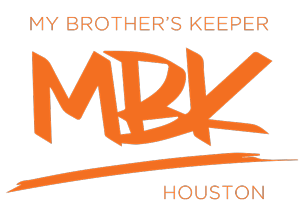Support Us
Support My Brother's Keeper by donating to the Houston Health Foundation. Select My Brother's Keeper (MBK) from the Fund dropdown menu.
Resources
Page last reviewed: January 22, 2024
My Brother's Keeper Houston

Our youth, particularly youth of color, face enormous challenges every day. Gaps between boys and young men of color, and the rest of the population, are found in education, earnings, health, employment, neighborhood safety, workforce development, and encounters with law enforcement and the justice system.

My Brother's Keeper Houston is an ambitious undertaking for our city. Improving future outcomes for our youth and children also means a better quality of life for all Houstonians. This translates to better economic conditions for families, access to quality education for all children and youth, improved health outcomes, a well-trained workforce, greater access to resources, safer neighborhoods, and a host of other factors.
As leaders and decision makers in our community, you can help.
The Houston Health Department serves as the backbone organization of My Brother's Keeper Houston to leverage the expertise of nonprofits, agencies, educational institutions and other partners to coalesce around strategies and evidence-based methodologies and programs seeking to increase opportunities and close disparity gaps that persist in our communities.
The Six Milestones
Research and experience have identified key milestones on the path to adulthood that are especially predictive of later success, and where interventions can have the greatest impact. At each of these markers, we see some children start to fall behind. Although the factors that influence success at each stage are complex and interdependent, by focusing on these milestones, doing what works and removing or avoiding roadblocks that hinder progress, we can provide young people the opportunity and the tools to get ahead.
-
Getting a Healthy Start and Entering School Ready to Learn
All children should have a healthy start and enter school ready – cognitively, physically, socially, and emotionally. -
Reading at Grade Level by Third Grade
All children should be reading at grade level by age 8 – the age at which reading to learn becomes essential. -
Graduating from High School Ready for College and Career
All youth should receive a quality high school education and graduate with the skills and tools needed to advance to postsecondary education or training. -
Completing Postsecondary Education or Training
Every American should have the option to attend postsecondary education and receive the education and training needed for the quality jobs of today and tomorrow. -
Successfully Entering the Workforce
Anyone who wants a job should be able to get a job that allows them to support themselves and their families. -
Keeping Kids on Track and Giving Them Second Chances
All youth and young adults should be safe from violent crime; and individuals who are confined should receive the education, training, and treatment they need for a second chance.
Cross-Cutting Strategies
Former President Obama’s My Brother’s Keeper Task Force also identified the following cross-cutting strategies that also remain core principles to our work:
- Enabling comprehensive, cradle-to-college-and-career community solutions;
- Learning from and doing what works;
- Making data about critical life indicators more transparent; and
- Empowering parents and engaging other caring adults
